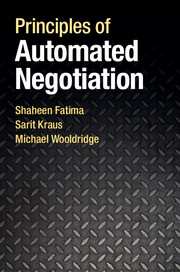Book contents
- Frontmatter
- Dedication
- Contents
- List of illustrations
- Preface
- Acknowledgements
- Summary of key notation
- 1 Introduction
- 2 Games in normal form
- 3 Games in extensive form
- 4 Negotiation domains
- 5 Strategic analysis of single-issue negotiation
- 6 Strategic analysis of multi-issue negotiation
- 7 The negotiation agenda
- 8 Multilateral negotiations
- 9 Heuristic approaches
- 10 Man–machine negotiations
- 11 Axiomatic analysis of negotiation
- 12 Applications
- 13 Related topics
- 14 Concluding remarks
- Appendix A Proofs
- References
- Index
6 - Strategic analysis of multi-issue negotiation
Published online by Cambridge University Press: 05 November 2014
- Frontmatter
- Dedication
- Contents
- List of illustrations
- Preface
- Acknowledgements
- Summary of key notation
- 1 Introduction
- 2 Games in normal form
- 3 Games in extensive form
- 4 Negotiation domains
- 5 Strategic analysis of single-issue negotiation
- 6 Strategic analysis of multi-issue negotiation
- 7 The negotiation agenda
- 8 Multilateral negotiations
- 9 Heuristic approaches
- 10 Man–machine negotiations
- 11 Axiomatic analysis of negotiation
- 12 Applications
- 13 Related topics
- 14 Concluding remarks
- Appendix A Proofs
- References
- Index
Summary
In many practical negotiations, the parties involved negotiate over not one but multiple issues. For example, when trading goods or services, buyers and sellers negotiate on the price, the quality, the method of payment, and other related issues. Political parties bargain over tax structures, foreign policy programmes, domestic spending programmes, etc. Nations negotiate trade terms in multiple markets.
One of the key differences between single and multi-issue negotiations is that, for the latter, the players may have different evaluations regarding the importance of the issues. We will study how these evaluations can be represented in the form of utility functions. Another difference is that multiple issues can be negotiated in different ways. For instance, the issues can all be discussed together or, alternatively, they can be discussed one-by-one in a sequence. A negotiation procedure specifies the way in which the issues will be negotiated. The procedure is crucial because the strategic behaviour of the players depends on it (Schelling, 1956, 1960; Sutton, 1986). Consequently, the outcome of such negotiations also depends on the procedure.
In this chapter, we begin by describing the main multi-issue procedures. Then, we analyse the players' strategic behaviour for different procedures and compare the procedures in terms of their equilibrium solutions.
- Type
- Chapter
- Information
- Principles of Automated Negotiation , pp. 97 - 120Publisher: Cambridge University PressPrint publication year: 2014



